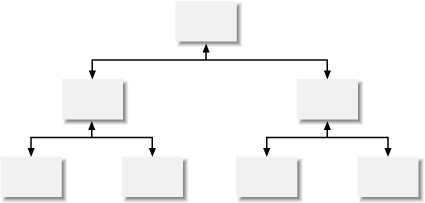Improving Flexibility
As we explained in Chapter 5, hierarchy is a familiar and powerful way of organizing information. In many cases, it makes sense for a hierarchy to form the foundation for organizing content in a web site. However, hierarchies can be limiting from a navigation perspective. If you have ever used the ancient information-browsing technology and precursor to the World Wide Web known as Gopher, you will understand the limitations of hierarchical navigation. In Gopherspace, you were forced to move up and down the tree structures of content hierarchies (see Figure 7-5). It was impractical to encourage or even allow jumps across branches (lateral navigation) or between multiple levels (vertical navigation) of a hierarchy.

Figure 7-5. The pure hierarchy of Gopherspace
The Web’s hypertextual capabilities removed these limitations, allowing tremendous freedom of navigation. Hypertext supports both lateral and vertical navigation. From any branch of the hierarchy, it is possible and often desirable to allow users to move laterally into other branches, to move vertically from one level to a higher level in that same branch, or to move all the way back to the main page of the web site. If the system is so enabled, users can get to anywhere from anywhere. However, as you can see in Figure 7-6, things can get confusing pretty quickly. It begins to look like an architecture ...
Get Information Architecture for the World Wide Web, Second Edition now with the O’Reilly learning platform.
O’Reilly members experience books, live events, courses curated by job role, and more from O’Reilly and nearly 200 top publishers.

